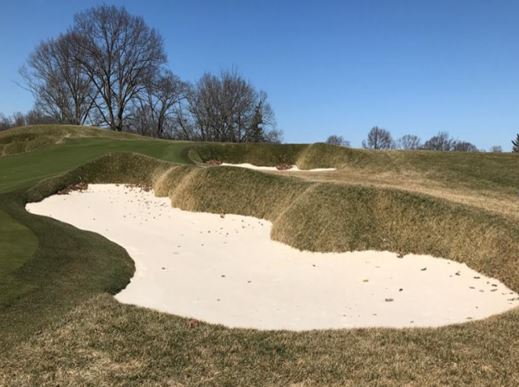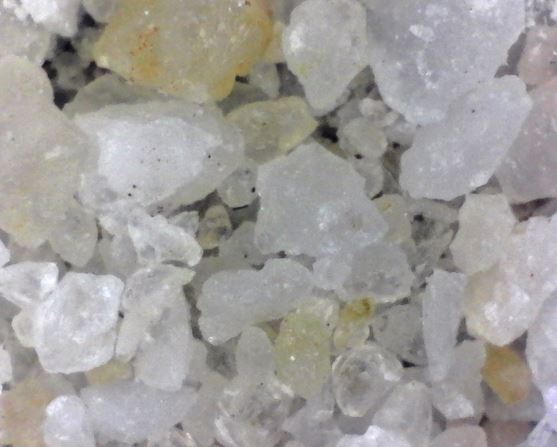It is mid-April and I should be planning field trips, perhaps even taking my first of the season. But like everyone else I am planted at home, watching the first responders and others attempting to defeat this virus. But what else have I been doing? Well, first off, the yard and all the rock gardens may look as good as they ever have by the time it is warm enough for growth to begin. And I have been taking walks, lots of walks: short walks, intermediate walks, and long walks. I am wearing my walking shoes out. I know every nook and cranny of my neighborhood.
On one of those long walks in late March, I was thinking about the New England beach trip for sand collecting that I was not going to be able to undertake. And I happened to be walking along the edge of Oak Hill Golf Course in my home town of Pittsford, NY. I saw sand, lots of sand. Of course, I know that golf course sand is not local, nor is it 100% natural. Nevertheless, I did wonder what it looked like and where it might come from.

As luck would have it, I had a small re-sealable snack bag in the pocket of my jacket (one should always be prepared), so I stepped to the edge of a greenside bunker on the par 3 3rd hole and took a wee bit. I hoped the course wouldn’t mind and promised myself to return the quarter of a cup of the white sand after I had taken a peak.
It was still a bit damp when I got it home, so I dried it in the kiln (er .. the oven), culled a couple of leaf fragments, and put it under my Zorb digital microscope for viewing. I observed medium-grained, sub-angular sand with a small component of larger grains and some fines also. About 10-20% of the grains were slightly iron-stained, but the overall color was quite white when viewed with the naked eye.

I turned to the internet and quickly learned that there is a huge science behind determining the optimal sand properties for golf course sand. And that the better golf course sands are not simply “mined”, but are rather meticulously manufactured. Among its credentials, Oak Hill Country Club has recently hosted the U.S. Open (1989), the Ryder Cup (1995), the US Senior PGA Championship (2019), and the PGA Championship (3 times and will again in 2023). Based on this, I assumed the sand I was looking at would be of the highest quality.
So what are the properties of high-quality golf course sand? First and foremost, medium-grained sand ranging from 0.25mm-1.0mm is desired, but there should be some fine material and a bit of coarser material also (perhaps 10% of each, but this can vary based on the topography of the trap and the regional climate). The mix of sizes helps with stability in bunkers with steep slopes, but too many fines can cause crusting and is also bad for the greens when wind-blown or golfer-distributed sand gets onto the green.
I was surprised to see (and learn) that highly angular grains/sub-angular grains are preferred to rounded grains, again to ensure greater firmness than round or sub-rounded grains would permit. The combination of purity (all quartz), grain-size, and grain shape is also required to prevent wayward golf balls from totally plugging or even completely burying. Bunkers are meant to be playable hazards for golfers, not outright disasters.
I do not know where Oak Hill obtains its sand, but I did learn that Augusta National Golf Course in Georgia (host to the Masters every other April except this year) obtains its brilliant white sand from pegmatite mines in Spruce Pine, NC. The sand is waste material from the primary quartz mining product of the region. Nearly all the quartz that goes into making computer silicon wafers worldwide comes from mines in the Spruce Pine area. But some of the waste quartz sand that does not get bagged for play sand, gets crushed to variable grain sizes and carefully mixed to meet the specific requirements of many of the nation’s golf courses.
Perhaps I should ask folks over at Oak Hill where they get their sand. After all, there are 49 bunkers along the 18 holes in the Famous East Course at Oak Hill. I wonder if the sand is similar in each one?
And then Golflink notes that there are 12 golf courses in Rochester, NY, and 49 golf courses within 20 miles of the city. I wonder how many different sources of sand those courses use? Do I need another project?
References:
Bigelow, C. A., et. al., 2008, Physical Analysis of Sands for Golf Course Bunker Use, USGA Research Online.
Clark, P., 2013, Digging deep into Western North Carolina’s mining history, Smoky Mountain Livi9ng Magazine, June issue
Moore, J. F., 1998, How to Select the Best Sand For Your Bunkers, USGA Green Section Record
Tremlett, S., 2020, Why are the Augusta National Bunkers White?, Golf Monthly
Wikipedia Entry: Oak Hill Golf Course

Hi Fred,
I recently finished my B.S. in Geology at SUNY Oswego and am now an Earth Science Teacher! I love geology and studying rocks! Thanks for posting some great information on this page. It has led to many rock hunting adventures.
Recently, because of the coronavirus I have had a lot of time on my hands so I started a business where I make art and jewelry out of rocks. I want to educate and raise awareness about how awesome New York State rocks and minerals are. I know morally and legally I cannot take rocks from public land and sell them so I have been reaching out to various Quarries all over New York, asking to buy small amounts of their rocks (I want to have a wide variety). I was wondering if you had any tips for contacting the Quarry owners/operators of some of the smaller quarries like Valentine Mine and Lewis Mine. The Blue Calcite and Unakite are so interesting , it would be so cool to collect some. Thanks again for providing great geological content!
Congratulations on completing your degree. Unfortunately, about two years ago the owners of the Valentine Mine stopped allowing access to clubs, although sometimes they do put material out on Hermitage Road for folks to pick up. Needless to say, I have not been up that way this year so do now know. I don’t know where you are located, but there is a mineral club in St. Lawrence County that you should look up when clubs start meeting and taking trips again. They have a webpage http://stlawrencecountymineralclub.org/ and you can reach Bill DeLorraine from there. If you are located south of there you might look us up (Wayne County Gem and Mineral Club), again once we are all meeting again. We have a webpage also (http://www.wcgmc.org/) and all of our newsletters (which I edit) are there. I can also say that most of us have lots of NY rock material that we would be willing to share should you be able to get down our way after we get back to having meetings and having workshops. You can read more about all of that in past newsletters.